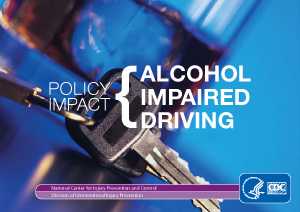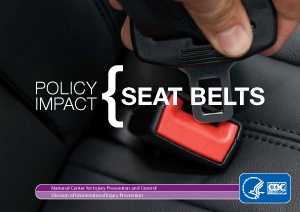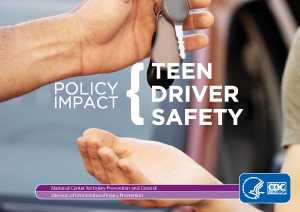Cost Data and Prevention Policies
Motor vehicle crashes are a leading cause of death a in the U.S.1 More than 2.5 million drivers and passengers were treated in emergency departments as the result of being injured in motor vehicle crashes in 2012.2 The economic impact is also notable: in a one-year period, the cost of medical care and productivity losses associated with injuries from motor vehicle crashes exceeded $80 billion.1
While these numbers are disturbing, there are effective measures that can help prevent motor vehicle injuries and deaths.
Motor Vehicle Prioritizing Interventions and Cost Calculator for States (MV PICCS) 2.0
 CDC offers a new interactive calculator, called the Motor Vehicle PICCS 2.0 (Prioritizing Interventions and Cost Calculator for States), pronounced “picks”. This tool will help state decision makers prioritize and select from a suite of 14 effective motor vehicle injury prevention interventions. It is designed to calculate the expected number and monetized value of injuries prevented and lives saved at the state level. The calculator also includes the costs of implementation, while taking into account available resources. A fact sheet for each intervention and a final report with a user guide are included.
CDC offers a new interactive calculator, called the Motor Vehicle PICCS 2.0 (Prioritizing Interventions and Cost Calculator for States), pronounced “picks”. This tool will help state decision makers prioritize and select from a suite of 14 effective motor vehicle injury prevention interventions. It is designed to calculate the expected number and monetized value of injuries prevented and lives saved at the state level. The calculator also includes the costs of implementation, while taking into account available resources. A fact sheet for each intervention and a final report with a user guide are included.
CDC Vital Signs
Motor Vehicle Crash Deaths: How is the US doing? (July 2016)
Motor Vehicle Crash Injuries: Costly but Preventable (October 2014)
Child Passenger Safety: Buckle up every age, every trip (February 2014)
Teen Drinking and Driving: A Dangerous Mix (October 2012)
State-Based Costs of Deaths from Crashes
 Over 30,000 people are killed in motor vehicle crashes each year in the United States. In 2013, crash deaths resulted in $44 billion in medical and work loss costs in addition to the immeasurable burden on the victims’ families and friends.
Over 30,000 people are killed in motor vehicle crashes each year in the United States. In 2013, crash deaths resulted in $44 billion in medical and work loss costs in addition to the immeasurable burden on the victims’ families and friends.
Policy Impact Briefs
Policy Impact is a series of issue briefs from CDC’s Injury Center highlighting key public health issues and important, science-based policy actions that can be taken to address them.

Policy Impact: Alcohol Impaired Driving
CDC supports efforts to strengthen policies related to preventing alcohol-impaired crash-related injuries and deaths.

Policy Impact: Seat Belts
CDC recommends effective, well-enforced seat belt laws to ensure that every person in every seat buckles up on every trip.

Policy Impact: Teen Driver Safety
This brief features critical information on crashes among teen drivers, as well as CDC’s recommendations for improving new driver safety.
Related Links
-
CDC WISQARS Cost of Injury Reports
WISQARS™ (Web-based Injury Statistics Query and Reporting System) provides cost estimates for injury deaths (including violent deaths) and nonfatal injuries where the patient was treated and released from a hospital or emergency department.
-
NHTSA: The Economic and Societal Impact Of Motor Vehicle Crashes, 2010
2014 NHTSA study shows motor vehicle crashes have $871 billion economic and societal impact on U.S. citizens.
-
Incidence and Total Lifetime Costs of Motor Vehicle-Related Fatal and Nonfatal Injury by Road User Type, United States, 2005
In a one-year period, the cost of medical care and productivity losses associated with injuries from motor vehicle crashes exceeded $99 billion - with the cost of direct medical care accounting for $17 billion, according to a study by the Centers for Disease Control and Prevention. The total annual cost amounts to nearly $500 for each licensed driver in the United States, said the study in the August 2010 issue of the journal Traffic Injury Prevention.
References
- CDC. WISQARS (Web-based Injury Statistics Query and Reporting System). Atlanta, GA: US Department of Health and Human Services, CDC; 2010. Available at https://www.cdc.gov/injury/wisqars. Accessed October 12, 2010.
- CDC. Vital Signs: Health Burden and Medical Costs of Nonfatal Injuries to Motor Vehicle Occupants – United States, 2012. Available at https://www.cdc.gov/VitalSigns/crash-injuries. Accessed October 7, 2014.
- Page last reviewed: May 31, 2017
- Page last updated: May 31, 2017
- Content source:
- Centers for Disease Control and Prevention,
- National Center for Injury Prevention and Control,
- Division of Unintentional Injury Prevention


 ShareCompartir
ShareCompartir

